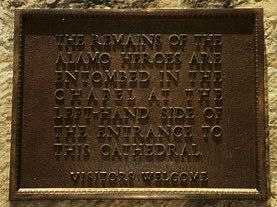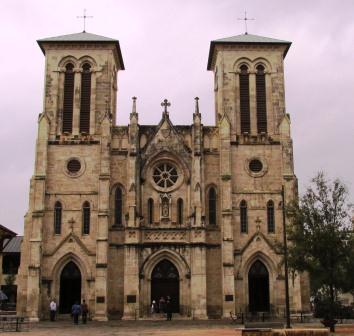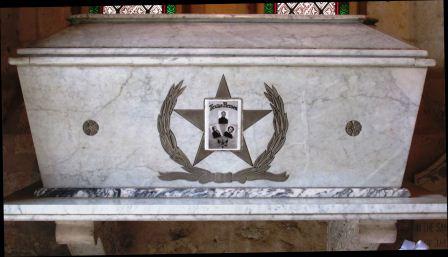Alamo Defender. He entered Mexican Texas in November 1833, as a livestock raiser and applied for a land grant in Joseph Vehlein's colony on November 4, 1834. His quarter-league grant, located on land now in Polk County, Texas, was surveyed on June 21, 1835, and the grant was issued on July 17, 1835. When the Texas Revolution broke out in the fall of 1835, he joined Captain John Crane's company of volunteers and participated in the siege of Bexar in November 1835. On December 14, 1835 he joined William R. Carey's artillery company and helped garrison the Alamo's canon defense. He died in the battle of the Alamo, his death probate inventory listed his possessions as including eighteen head of cattle, eleven hogs, and a "Brand Iron."
He was the only representative from Illinois at the Alamo.
*************
Jonathan L. Lindley, 22, born 12 Feb 1814 in SangamonCo, IL was a surveyor for early Texas colonists and resident of Gonzales. He was a Private artilleryman in Capt. Carey's artillery company of the Alamo garrison. He was the third child and oldest son of Samuel Washington Lindley (b. 1788 NC). Lindley is said to have come to the DeWitt Colony from IL in 1833. According to descendants, after the death of his first wife Mary (Polly) Elizabeth Hall abt 1809 shortly after the birth of first child Sarah, he married Elizabeth Whitley with whom he had his remaining children except Amanda. On 3 May 1835 single Jonathan was granted a quarter league of land in the William Pace survey in PolkCo, TX. He participated in the Battle of Bexar on 14 Dec 1835 after which he as many others returned home for Christmas hoping that the Revolution was over. Lindley joined Capt. Carey's Company in the regular Texas Army in the fall of 1835. Lindley was at home in Gonzales when he joined the Gonzales Relief Force to return to his post at the Alamo. His heirs received 1280 acres bounty for service in PanolaCo, TX near Carthage. After the Battle of San Jacinto, the surviving Lindley family re-settled in MontgomeryCo, TX. In the Lindley Cemetery 5 miles north of Anderson in GrimesCo, TX is a historical marker honoring Jonathan L. Lindley.
Family records indicated that the Lindley clan originated in England and Ireland and the first family immigrated to America circa 1713 and settled in New Jersey [Some reports suggest the family migrated to Pennsylvania, the Carolinas, Indiana and then Illiniois-WLM]. By 1811 they had settled in Sangamon County, Illinois and from that time and place the records were authenticated. Samuel Washington Lindley born in 1788 in North Carolina married a woman named Elizabeth [Whitley] and while living in Illinois ten children were born to that union: Barsheba (March 5, 1811); Polly (1812); Jonathan (February 12, 1814); Elizabeth (March 24, 1815); William (September 29, 1817); Martha (July 30, 1821); Samuel W. Jr. (July 30,1823); Rachel (1827); John (1829); and James (March 13, 1831). Jonathan, the third child and eldest son of Samuel W. and Elizabeth, went to Texas with his family in 1833 to colonize land in the DeWitt Colony. As an unmarried man, on July 17, 1835 he was granted a one-fourth league of land (640 acres) as a headright in the William Pace Mexican League, originally titled May 3, 1835. Jonathan was a surveyor and spent most of his time surveying the land of other colonists. Jonathan was greatly influenced by the early leaders of Texas during the pre-Texas Revolution period. Jonathan was with Ben Milam when the Texans took San Antonio in December, 1835. Jonathan with many others left San Antonio before Christmas, 1835 and returned to their families, believing that the revolution was about over. Tradition stated that Jonathan was the true spirit that kindled the flame for freedom in the Lindley family. As evidenced by a document containing information given by his father, Jonathan joined the Texas Revolutionary forces in the fall of 1835. A document of the Republic of Texas signed May 14, 1839 by General Albert Sidney Johnston, Secretary of War, Republic of Texas, further gave evidence that Jonathan Lindley joined the army of Texas December 14, 1835 and served until his death at the Alamo March 6,1836. At Gonzales in late February, 1836 after calls for aid from Travis at the Alamo, Jonathan joined Captain Albert Martin's band of men who were later known as "The Immortal Thirty-Two Men from Gonzales." Jonathan Lindley, with the other defenders of the Alamo, was killed March 6, 1836. Following the independence of Texas, the grateful Republic of Texas posthumously awarded the heroes of the Alamo bounties of land. Under certificate #9132 dated May 14, 1839, Houston, Texas Jonathan Lindley was awarded 1280 acres of land situated in Panola County, ten and one-half miles south, twenty degrees west from Carthage, Texas. It was patented March 9, 1860. The lawful heirs of Jonathan Lindley, namely his parents and his brothers and sisters, since he was not married, fell heir to the 1280-acre bounty plus his original Mexican Grant of 640 acres in the William Pace Survey in Polk County. His father, Samuel Washington Lindley, was appointed administrator of the estate of Jonathan; as such he administered and divided the estate. After the battle of San Jacinto the Lindley family opted to re-settle in Montgomery County. In the Lindley Cemetery five miles north of Anderson, Grimes County was erected an historical marker honoring Jonathan Lindley as an Alamo hero.
Source: (used with permission): Alamo Defenders-Index
SONS OF DEWITT COLONY TEXAS
Wallace L. McKeehan, All Rights Reserved
Alamo Defender. He entered Mexican Texas in November 1833, as a livestock raiser and applied for a land grant in Joseph Vehlein's colony on November 4, 1834. His quarter-league grant, located on land now in Polk County, Texas, was surveyed on June 21, 1835, and the grant was issued on July 17, 1835. When the Texas Revolution broke out in the fall of 1835, he joined Captain John Crane's company of volunteers and participated in the siege of Bexar in November 1835. On December 14, 1835 he joined William R. Carey's artillery company and helped garrison the Alamo's canon defense. He died in the battle of the Alamo, his death probate inventory listed his possessions as including eighteen head of cattle, eleven hogs, and a "Brand Iron."
He was the only representative from Illinois at the Alamo.
*************
Jonathan L. Lindley, 22, born 12 Feb 1814 in SangamonCo, IL was a surveyor for early Texas colonists and resident of Gonzales. He was a Private artilleryman in Capt. Carey's artillery company of the Alamo garrison. He was the third child and oldest son of Samuel Washington Lindley (b. 1788 NC). Lindley is said to have come to the DeWitt Colony from IL in 1833. According to descendants, after the death of his first wife Mary (Polly) Elizabeth Hall abt 1809 shortly after the birth of first child Sarah, he married Elizabeth Whitley with whom he had his remaining children except Amanda. On 3 May 1835 single Jonathan was granted a quarter league of land in the William Pace survey in PolkCo, TX. He participated in the Battle of Bexar on 14 Dec 1835 after which he as many others returned home for Christmas hoping that the Revolution was over. Lindley joined Capt. Carey's Company in the regular Texas Army in the fall of 1835. Lindley was at home in Gonzales when he joined the Gonzales Relief Force to return to his post at the Alamo. His heirs received 1280 acres bounty for service in PanolaCo, TX near Carthage. After the Battle of San Jacinto, the surviving Lindley family re-settled in MontgomeryCo, TX. In the Lindley Cemetery 5 miles north of Anderson in GrimesCo, TX is a historical marker honoring Jonathan L. Lindley.
Family records indicated that the Lindley clan originated in England and Ireland and the first family immigrated to America circa 1713 and settled in New Jersey [Some reports suggest the family migrated to Pennsylvania, the Carolinas, Indiana and then Illiniois-WLM]. By 1811 they had settled in Sangamon County, Illinois and from that time and place the records were authenticated. Samuel Washington Lindley born in 1788 in North Carolina married a woman named Elizabeth [Whitley] and while living in Illinois ten children were born to that union: Barsheba (March 5, 1811); Polly (1812); Jonathan (February 12, 1814); Elizabeth (March 24, 1815); William (September 29, 1817); Martha (July 30, 1821); Samuel W. Jr. (July 30,1823); Rachel (1827); John (1829); and James (March 13, 1831). Jonathan, the third child and eldest son of Samuel W. and Elizabeth, went to Texas with his family in 1833 to colonize land in the DeWitt Colony. As an unmarried man, on July 17, 1835 he was granted a one-fourth league of land (640 acres) as a headright in the William Pace Mexican League, originally titled May 3, 1835. Jonathan was a surveyor and spent most of his time surveying the land of other colonists. Jonathan was greatly influenced by the early leaders of Texas during the pre-Texas Revolution period. Jonathan was with Ben Milam when the Texans took San Antonio in December, 1835. Jonathan with many others left San Antonio before Christmas, 1835 and returned to their families, believing that the revolution was about over. Tradition stated that Jonathan was the true spirit that kindled the flame for freedom in the Lindley family. As evidenced by a document containing information given by his father, Jonathan joined the Texas Revolutionary forces in the fall of 1835. A document of the Republic of Texas signed May 14, 1839 by General Albert Sidney Johnston, Secretary of War, Republic of Texas, further gave evidence that Jonathan Lindley joined the army of Texas December 14, 1835 and served until his death at the Alamo March 6,1836. At Gonzales in late February, 1836 after calls for aid from Travis at the Alamo, Jonathan joined Captain Albert Martin's band of men who were later known as "The Immortal Thirty-Two Men from Gonzales." Jonathan Lindley, with the other defenders of the Alamo, was killed March 6, 1836. Following the independence of Texas, the grateful Republic of Texas posthumously awarded the heroes of the Alamo bounties of land. Under certificate #9132 dated May 14, 1839, Houston, Texas Jonathan Lindley was awarded 1280 acres of land situated in Panola County, ten and one-half miles south, twenty degrees west from Carthage, Texas. It was patented March 9, 1860. The lawful heirs of Jonathan Lindley, namely his parents and his brothers and sisters, since he was not married, fell heir to the 1280-acre bounty plus his original Mexican Grant of 640 acres in the William Pace Survey in Polk County. His father, Samuel Washington Lindley, was appointed administrator of the estate of Jonathan; as such he administered and divided the estate. After the battle of San Jacinto the Lindley family opted to re-settle in Montgomery County. In the Lindley Cemetery five miles north of Anderson, Grimes County was erected an historical marker honoring Jonathan Lindley as an Alamo hero.
Source: (used with permission): Alamo Defenders-Index
SONS OF DEWITT COLONY TEXAS
Wallace L. McKeehan, All Rights Reserved
Bio by: John "J-Cat" Griffith
Family Members
Advertisement
Explore more
Sponsored by Ancestry
Advertisement

















